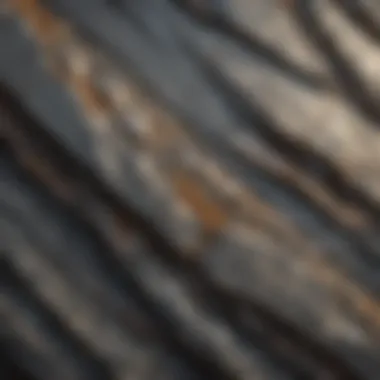Unveiling the Enchanting World of Granite Through Mesmerizing Photos


Rock and Fossil Identification
Collecting Tips and Techniques
In the realm of collecting granite specimens, knowing the types of granite and their characteristics is essential. Look for variations in color, texture, and mineral composition when identifying different types of granite. Utilizing tools like geologist hammers, chisels, and safety goggles can aid in the safe extraction and examination of granite specimens. Prime collecting sites for granite often include mountains, quarries, and areas with exposed rock formations. Exercise caution when extracting specimens to preserve both your safety and the integrity of the rock.
Preservation and Display
Take into consideration the preservation and display of your granite treasures with meticulous care. Techniques such as cleaning with a soft brush and storing in a cool, dry place can help maintain the rock's luster and integrity over time. Explore creative display ideas such as shadow boxes, glass domes, or custom stands to showcase the unique beauty of your granite specimens. Proper storage methods, including wrapping specimens in acid-free paper or cloth, can prevent damage and ensure their longevity.
Geological Insights
Unravel the geological mysteries of granite through its formations and historical significance. Delve into the processes that shaped granite over millennia, from molten magma to solid rock, creating intricate patterns and structures along the way. Discover the historical and cultural significance of granite, from ancient monuments to modern architecture, highlighting its enduring presence in our world. Explore notable discoveries in the field of geology related to granite, shedding light on new findings that continue to deepen our understanding of this mesmerizing igneous rock.
Introduction to Granite
Granite, one of the most fascinating igneous rocks found on Earth, serves as a cornerstone in the world of geology and construction. In this article, the focus is on unraveling the captivating essence of granite through a series of visually arresting photographs. By delving into the intricate patterns, diverse color palettes, and the geological significance of granite, readers will embark on a mesmerizing journey that celebrates the uniqueness and complexity of this rock.
Understanding Granite Composition
Mineral Composition of Granite
The mineral composition of granite, characterized by a blend of quartz, feldspar, and mica crystals, plays a crucial role in determining the rock's texture, color, and durability. Quartz lends granite its hardness and translucency, while feldspar provides variations in color, ranging from pinks to whites to grays. Mica, known for its shimmering effect, adds a touch of elegance to granite surfaces. This intricate mix of minerals not only enhances the visual appeal of granite but also contributes to its resilience against environmental elements, making it a preferred choice for both interior and exterior applications.
Formation Process of Granite


The formation process of granite is a complex and lengthy journey that begins deep within the Earth's crust. As molten magma cools and solidifies over millions of years, the minerals within it undergo crystallization, forming interlocking crystals that give granite its distinctive grainy texture. The slow cooling process allows for the minerals to arrange themselves in a specific pattern, creating unique veins and color variations within the rock. This gradual formation results in a rock that is not only visually stunning but also incredibly durable, making it a highly sought-after material for architectural and decorative purposes.
Exploring Granite Patterns
In the realm of granite exploration, understanding the intricate patterns embedded within this igneous rock is crucial. Exploring Granite Patterns holds a paramount significance in our quest to unravel the enigmatic allure of granite through captivating photography. This section delves deep into the mesmerizing tapestry of veins and designs that adorn granite formations, providing insights into their composition, aesthetics, and geological implications.
Veins and Intricate Designs
Veins and Intricate Designs stand as the hallmark of granite's visual appeal, capturing the essence of its formation and character. Mineral Veining in Granite serves as a captivating aspect within this domain, depicting the intricate network of minerals that flow through granite, shaping its unique identity. This subsection elucidates the key characteristic of Mineral Veining in Granite – the interplay of various minerals creating mesmerizing patterns and colors that add depth and complexity to the rock. The intricate amalgamation of minerals in this process not only enhances the visual interest of granite but also underscores its geological significance, showcasing the dynamic forces at play beneath the Earth's surface.
On the other hand, Unique Pattern Variations in Granite offer a spectrum of diverse patterns that elevate granite's aesthetic allure. These variations provide a visual feast for photography enthusiasts, showcasing the breadth of possibilities inherent in granite patterns. By exploring the nuances of Unique Pattern Variations in Granite, photographers can capture the essence of individuality that each granite slab embodies, amplifying the richness and diversity of this natural marvel. From bold swirls to delicate speckles, these patterns offer a palette for artistic expression, inviting viewers to appreciate the intricate beauty and complexity that granite beholds.
With a keen focus on Veins and Intricate Designs, this section not only showcases the artistic splendor of granite patterns but also delves into the deeper layers of its geological and compositional significance. By shedding light on the interplay of minerals and the unique variations in granite patterns, this exploration sets the stage for a profound understanding and appreciation of granite through the lens of captivating photography.
Diverse Color Palette of Granite
In the realm of granite exploration through captivating photography, the Diverse Color Palette of Granite stands as a pivotal element. The variation in hues and tones exhibited by different granite formations adds a layer of intrigue and beauty to this igneous rock. Each coloration tells a unique story of the geological forces and mineral composition that shaped it, providing a visual feast for photographers and rock enthusiasts alike.
The significance of delving into the Diverse Color Palette of Granite within the context of this article lies in its ability to showcase the vast spectrum of colors that granite can exhibit. From earthy browns and vibrant greens to delicate pinks and striking blues, the diversity in granite hues offers a rich tapestry for artistic exploration and geological study. By focusing on the colors present in granite formations, readers gain a deeper appreciation for the complexity and beauty inherent in these natural wonders.
Exploring the Diverse Color Palette of Granite not only elucidates the aesthetic appeal of this igneous rock but also sheds light on the geological processes that contributed to its formation. Through a close examination of color variations, readers can gain insights into the types of minerals present in the granite, as different minerals impart distinct colors to the rock. This section paves the way for a deeper understanding of the intricate relationship between mineral composition and coloration in granite, enhancing the overall exploration of this fascinating subject.
Geological Significance of Granite
Granite holds a crucial role in the geological landscape, which is paramount to understand its significance in this article showcasing captivating photos. As one of the most abundant rocks in the Earth's crust, granite plays a vital role in shaping natural terrains and processes. Its composition, durability, and presence contribute to various geological phenomena, making it a central topic to explore through photography in this context.


Granite in Earth's Crust
Role of Granite in Tectonic Processes
When discussing the role of granite in tectonic processes, it is essential to highlight its impact on the Earth's crust dynamics. Granite, known for its intrusive nature, interacts dynamically with other rocks, influencing the formation of mountain ranges, faults, and seismic activities. Its ability to withstand immense pressure and heat plays a crucial part in the formation and maintenance of geological structures, making it a fundamental component in the tectonic puzzle.
Granite's Impact on Landscapes
Exploring granite's impact on landscapes sheds light on the visible manifestations of this igneous rock in nature. Granite formations create stunning landforms, from majestic rock formations to vast mountain ranges, contributing to the aesthetic and geological diversity of Earth's terrain. Through its erosion-resistant properties, granite sculpts intricate landscapes over time, showcasing the enduring beauty and resilience of this rock in shaping the world around us.
Photographic Showcase of Granite
In the world of geology, the Photographic Showcase of Granite serves as a crucial tool for both education and admiration. Through the lens of a camera, granite's intrinsic beauty and complexity are brought to life, transcending mere physical presence into visual artistry. This section of the article plays a pivotal role in immersing the audience in the captivating realm of granite, offering a unique perspective that words alone cannot convey. By showcasing stunning visuals of granite formations and patterns, this photographic journey elevates the understanding and appreciation of this igneous rock to new heights.
Visual Splendor of Granite
Close-up Shots of Granite Surfaces
Close-up shots of granite surfaces provide a mesmerizing peek into the intricate details and textures that compose this remarkable rock. Each photograph captures the smallest nuances, revealing the unique mineral composition and crystalline structure that makeup granite. These close-up shots allow for a deep dive into the heart of granite, showcasing its diversity and complexity in a visually arresting manner. The benefit of such detailed images lies in their ability to unveil the raw beauty of granite, showcasing its innate patterns and colors in exquisite detail for enthusiasts and collectors alike.
Scenic Views of Granite Formations
On the other hand, scenic views of granite formations offer a broader perspective, highlighting the grandeur and vastness of granite landscapes. These photographs capture the essence of geological time, showcasing how granite interacts with its surroundings to form majestic formations that awe and inspire. By presenting granite in its natural habitat, these scenic views evoke a sense of wonder and appreciation for the geological processes that have shaped our planet. The advantage of including scenic views lies in providing a holistic view of granite, situating it within the larger context of geological formations and landscapes, thereby enriching the viewer's understanding of this remarkable rock.
Interpreting Granite Through Photography


Interpreting Granite Through Photography is a crucial aspect of this captivating article, as it serves as a bridge between the scientific exploration of granite and its artistic representation. By delving into the depths of granite through the lens of a camera, we can witness the intricate details and unique patterns that make this igneous rock a visual masterpiece. Photography adds a new dimension to our understanding of granite, allowing us to capture its essence in a way that words alone cannot convey.
Artistic Perspective on Granite
Photography Techniques for Capturing Granite
Photography Techniques for Capturing Granite play a pivotal role in bringing out the beauty of this natural wonder. From using specific lighting to employing close-up shots, these techniques enable photographers to showcase the unique features and textures of granite. By focusing on the details and colors of granite, photographers can create visually appealing images that highlight the rock's complexity and aesthetic appeal. One key characteristic of Photography Techniques for Capturing Granite is their ability to transform a simple rock formation into a work of art, engaging the viewer and evoking a sense of wonder.
Emphasizing Texture and Depth in Granite Images
Emphasizing Texture and Depth in Granite Images is a fundamental aspect of capturing the essence of this igneous rock. By focusing on the rugged surface texture and depth variations of granite, photographers can convey the rock's geological history and unique characteristics. This technique adds visual interest to images, allowing viewers to appreciate the intricate patterns and subtleties of granite formations. While emphasizing texture and depth enhances the aesthetic quality of granite images, it also provides valuable insight into the geological processes that have shaped these magnificent rocks.
Conclusion: A Visual Ode to Granite
Granite, an igneous rock of remarkable beauty and complexity, has been the subject of fascination for centuries. Within this article, 'A Visual Ode to Granite' serves as the pinnacle, encapsulating the essence of this mesmerizing rock through captivating photography. By delving into the diverse hues, intricate patterns, and geological significance of granite, we have embarked on a visual odyssey that celebrates its unique characteristics.
From the formation processes that shape its stunning visuals to the artistic interpretations captured through photography techniques, this section serves as both a culmination and a continuation of our exploration. By immersing ourselves in the visual splendor of granite, we gain a deeper appreciation for its role in Earth's landscapes and tectonic processes.
Through showcasing close-up shots that reveal the granular textures and structures of granite surfaces, as well as presenting scenic views that highlight its grandeur on a larger scale, 'A Visual Ode to Granite' offers a comprehensive perspective on this enduring geological marvel.
Appreciating the Beauty of Granite
Reflection on the Diversity of Granite
Reflecting on the diversity of granite unveils a multitude of colors, patterns, and mineral compositions that showcase the versatile nature of this rock. This aspect contributes significantly to our overall understanding of granite's allure and geological importance. The key characteristic of this reflection lies in its ability to showcase the rich tapestry of granite types, from common colors with their origins deeply rooted in mineral influences to rare colorations that add a sense of exclusivity to this igneous wonder.
The unique feature of reflecting on the diversity of granite is the way it sheds light on the immense variety present in granite formations worldwide, highlighting the vast range of possibilities and visual delights that photographers can capture. While this diversity offers endless creative opportunities, it also challenges enthusiasts to explore and appreciate the nuances that make each granite specimen truly one-of-a-kind.
Impact of Photography on Granite Appreciation
The impact of photography on granite appreciation cannot be overstated within the context of this article. Photography serves as a powerful medium through which the intricate details, textures, and depths of granite can be visually conveyed and celebrated. This key characteristic enhances the overall viewing experience by allowing enthusiasts to explore granite in a way that transcends traditional observation.
The unique feature of photography lies in its ability to immortalize the beauty of granite, preserving fleeting moments in time and capturing the essence of this igneous marvel for future generations to admire. While photography offers numerous advantages in showcasing granite's allure, such as drawing attention to its nuances and textures, it also poses challenges in accurately representing the true magnificence of granite formations, requiring a keen eye for composition and lighting to do justice to this geological masterpiece.







